Palliser-Winkelmann WDB1 car-by-car histories
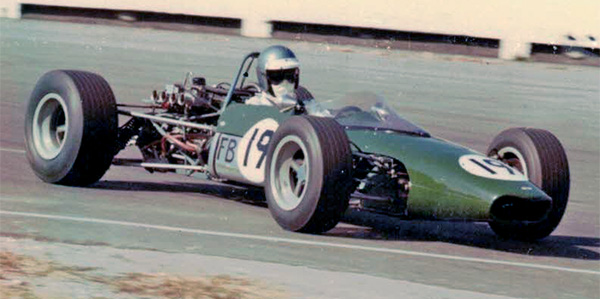
Dan Murphy in his Winkelmann WDB1 at Milwaukee in 1968. Copyright Jacques Dresang 2025. Used with permission.
The Palliser WDB1 was a completely new design produced by Palliser for SCCA Formula B in 1968. It was marketed in the US under the Winkelmann name, as Bob Winkelmann oversaw the American operation.
The Palliser marque was born out of a conversation between Brabham factory foreman Len Wimhurst and customer Hugh Dibley, when Wimhurst suggested that he could build a car for Dibley to his own design. Dibley accepted, and the car was built by Wimhurst at his home in Catford in south-east London. It was entered as TBN (To Be Named) for Dibley's first race in it, a Hagley & District Light Car Club Formule Libre race at Castle Combe on 30 September 1967. Dibley was greatly impressed and took photographs of the car out to California to show them to an expat Englishman, Bob Winkelmann, who was heavily involved in the import of British racing cars into America. Winkelmann was the brother of Roy Winkelmann, whose Formula 2 team had just had to abandon its plans to build an F1 car for Jochen Rindt after Firestone had withdrawn its financial support. This alternative way to introduce a Winkelmann-branded racing car may have been perfectly timed.
Winkelmann was convinced of the need for a larger and stronger car for the SCCA's 1600cc Formula B, partly to accommodate the taller and broader American drivers, but also to survive the airfields and public park roads that made up many of the circuits used in SCCA racing. He placed an order for three Formula B cars, and Dibley flew back to England to form Palliser Racing Design Ltd. Palliser was Dibley's middle name, and his mother's maiden name. The directors of the company were Dibley, Wimhurst and Winkelmann, with Winkelmann acting as sales director and focusing on the lucrative American market.
Wimhurst's design was quite orthodox: a well-triangulated spaceframe chassis with double wishbone suspension and outboard springs at the front, and a single top link, reversed lower wishbone and twin radius rods at the rear. All the WDB1s were supplied with 10-inch front and 12-inch rear wheels, and with Hewland Mk 5 gearboxes. The cars were marketed in the US as Winkelmann WD-1s, not Pallisers, and although the initial reports in 1968 mentioned Wimhurst, later press reports described the cars as having been designed and manufactured by Bob Winkelmann himself. The WD-1 name only changed to WDB1 retrospectively when a Formula Ford WDF1 was introduced to the range later in 1968.
If you can add to our understanding of these Palliser-Winkelmanns, or have photographs that we can use, please email Allen at allen@oldracingcars.com.
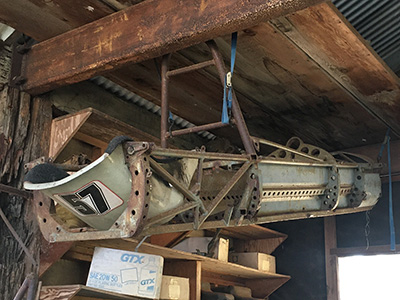
The "prototype" Formula B Winkelmann in Bob Winkelmann's loft. Copyright Evan McGreevy 2025. Used with permission.
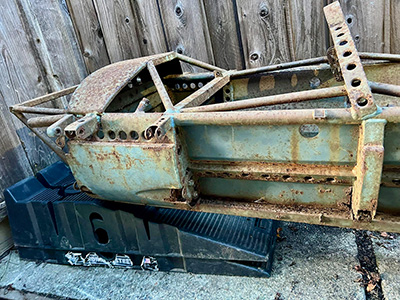
The “prototype” Formula B Winkelmann photographed in 2014. Copyright Locke de Bretteville 2025. Used with permission.
The prototype Palliser, described in the press as a "one-off Formula 2 car", was fitted with a 1600cc Ford twin cam engine and raced by Hugh Dibley in a Hagley & District Light Car Club's Hunt Trophy for Formule Libre and F3 cars at Castle Combe in late September 1967. He qualified third, alongside a Cooper-Monaco on pole and Jim Moore's mighty Kincraft Formule Libre car. While Moore set off into the lead, Autosport reported that Dibley "coasted around Quarry and stopped in the country with fuel starvation troubles". With the season now over, there was no opportunity to race the car again, and the new company focused on producing variants of the car for SCCA Formula B.
The frame sat around for some time, and was eventually included in a shipment of cars to Robert Winkelmann after he heard that Palliser were going to dispose of it. The car remained in a storage area with him for many years, eventually hanging in the roof of an outbuilding at his home in Muir Beach, CA. Winkelmann died in March 2024, at the age of 95. In July, the Palliser frame and all associated components were acquired by Steve Beale (Petaluma, California). Still owned by Beale in September 2025.
Driven by: Hugh PK Dibley. First race: Castle Combe, 30 Sep 1967. Only one recorded race.
Built for Robert Winkelmann (Mill Valley, CA) to race in SCCA Formula B in 1968. The car was identified as a Winkelmann "WD-1" when it first appeared and in some later press reports. It was given its debut by Hugh Dibley in an FRA race at Vina Raceway in June 1968, before Winkelmann drove it in an SCCA National at Riverside the next weekend. He later took pole position at San Diego and then won two SCCA Nationals in two days in September: at Mid-America Raceway on the Saturday and Odessa Raceway Park on the Sunday, after a 1000-mile overnight tow. Winkelmann's sales list for the WDB1s shows this as the car sold to Bob Ilg (Salt Lake City, UT) for SCCA Formula B in 1970. First seen in Ilg's hands when he raced it in the SCCA Continental Championship race at Continental Divide in June 1969. Like Dan Murphy's car, it was sometimes entered as a "WD-1" even in Ilg's ownership. Retained by Ilg for 1970, when he raced it twice at Bonneville Raceway Park. Advertised by Ilg in October 1970. Subsequent history unknown.
Driven by: Hugh PK Dibley, Robert Winkelmann and Bob Ilg. First race: Vina Raceway (R2), 2 Jun 1968. Total of 12 recorded races.
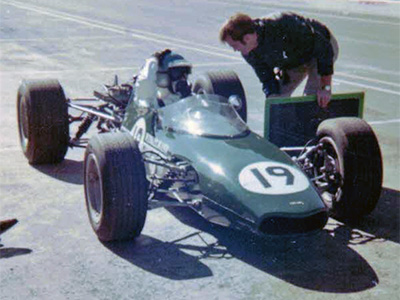
Dan Murphy in his Winkelmann WDB1 at Milwaukee in 1968. Copyright Jacques Dresang 2025. Used with permission.
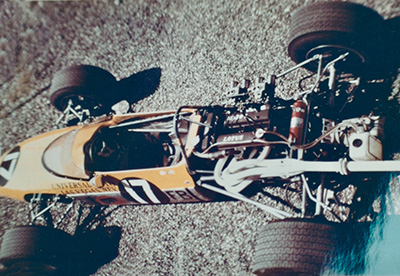
A picture of Steve Rzesnowiecky's Winkelmann WDB1 provided to the Registry by Mike Fazzi. Copyright Palliser-Winkelmann Registry 2025. Used with permission.
New to Dan Murphy (Plymouth/Racine, WI) for SCCA Formula B, and initially entered as a "WD-1". Raced by Murphy in Central Division and Midwest Division SCCA Nationals and in the Continental Championship Donnybrooke Grand Prix at Brainerd in September. According to Bob Winkelmann's sales list, this car was sold to Stefan Rzesnowiecky (Las Vegas, NV) for 1970. Rzesnowiecky, also known as Steve, raced the car in the 1969 SCCA Continental Championship events at Riverside and Continental Divide, but did not appear again in Pro events. He finished second in an SCCA National at Bonneville Raceway Park in September 1969. He retained the car for SCCA Nationals in 1970, and his last known race with the car in FB was an SCCA Regional at Phoenix in late September 1970. In 1971, Rzesnowiecky raced at least once in Formula C in a Winkelmann, and given the lack of FC Winkelmanns and the unlikelihood of Rzesnowiecky having bought a second, different, Winkelmann, it would be reasonable to conclude that this was the same car. Rzesnowiecky was not seen again with the car, but Mike Kuhn (Spokane, WA) ran a Winkelmann FC in ICSCC racing in 1975, and there is a good chance this was the same car. Kuhn then appeared with a "Bestway Spl" in FC in 1976, then a Tipke FC later that year. Subsequent history unknown, but see 'the Mike Fazzi car'.
Driven by: Dan Murphy and Stefan Rzesnowiecky. First race: Blackhawk Farms (R7), 25 Aug 1968. Total of 9 recorded races.
New to Rodolfo Junco de la Vega (Monterrey, Mexico) and first seen in November 1968 on display at the new Winkelmann of Texas showroom at the Texas Speed Museum in Austin, TX. Newspaper magnate Junco had previously been racing his Formula Ford Lotus 51 in Formula B races in Texas. He debuted the Winkelmann in an SCCA Regional at Green Valley Raceway in December 1968, winning comfortably. He then raced the car in the 1969 SCCA Continental Championship, but after competing at Riverside and Continental Divide, he did not appear again. The car was described as a "WD-1" in some local press reports. Subsequent history unknown, but see 'the Butch Harris car'.
Driven by: Rodolfo Junco. First race: Green Valley Raceway, 8 Dec 1968. Total of 3 recorded races.
The original 1968-69 Palliser-Winkelmann WDB1s
The first three spaceframe Palliser chassis were fabricated by Wimhurst at his home, and then in late 1968 the company moved into premises at North Street, Clapham, in south London. Production of chassis frames was outsourced to Arch Motors in Huntingdon, and assembly took place at North Street. The cars' fibreglass bodywork was produced by Specialised Mouldings, who were handily located next door to Arch. Palliser also made their own wheels, magnesium uprights, steering racks and other components, with castings produced by Kent Alloys, just 30 miles down the A2 at Strood.
The first Palliser-Winkelmanns to be delivered to the US were the Formula B cars for Winkelmann himself and for Dan Murphy, the new company's first customer. Early results were impressive, and on one weekend in September 1968 Winkelmann won two SCCA Nationals on consecutive days, at Mid-America Raceway in St Louis, Missouri, and at Odessa Raceway Park more than 900 miles away in west Texas, having towed all night. The timing of this triumph was perfect for Jerome Shield, who had just been appointed as the Winkelmann agent for the southwest, having previously run Dick Negley's Lotus 41C in Southwest Division FB. Shield quickly took orders for Formula Ford versions of the car from Texans who found the Palliser frame suited them better than the more slender Lotus 51. The third Formula B car was sold to Mexican newspaper publisher and local Lone Star Region member Rodolfo Junco de la Vega, and by the time Junco's car reached Shield's Austin showroom in November 1968, the first Formula Ford Winkelmann WDF1s were also "on the water" and due to arrive soon in the docks in Houston. The press in Texas reported John Hancock taking delivery of "the world's first Winkelmann Formula Ford" on Wednesday 4 December 1968. Texas racers Joe Duran and Gordon Beavers were also near the top of the queue for Winkelmann WDF1s. Skip Adrian and Jack Cowell also bought WDF1s, and would later progress to Formula B Winkelmanns. Although many Formula Fords had already arrived in the US during 1968, the SCCA did not organise a specific category for them until 1969 so they had to compete in FB in 1968. Formula Ford Winkelmanns continued to appear in FB races into 1969.
Bob Winkelmann provided a list to the Palliser-Winkelmann Registry of WDB1 sales from 1 January 1969. This showed Winkelmann's own car going to Ilg, and Murphy's going to Rzesnowiecky. It then shows a blue car going to Junco and a white car going to Butch Harris. These two sales are annotated June 1968 and April 1969 respectively, but press reports showed Junco's car arriving in late November 1968 and the sale to Harris does not appear to have taken place until July 1969, as he was "first time out" at a race on 3 August. As Winkelmann repeatedly referred in interviews and articles to three WDB1s having been built, not four, it is possible that Winkelmann was recording a fourth sale, not a fourth car, and that Harris had been sold the ex-Junco WDB1-3, which had last been seen in June 1969.
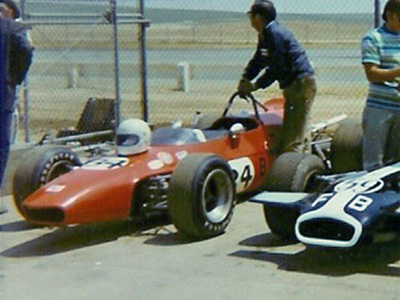
Butch Harris's Winkelmann WDB1 at Riverside in April 1970. Copyright Sandy Shepard 2012. Used with permission.
Raced by Cecil "Butch" Harris (Houston, TX) in SCCA Southwest Division Formula B in 1969. Bob Winkelmann's sales list shows this car as '004', but given how late it was sold to Harris, it remains a possibility that Harris acquired the ex-Rodolfo Junco WDB1-3. Harris raced in Formula Vee earlier in the 1969 season, and will have seen the success of new Winkelmann Formula Fords in the hands of John Hancock and others. He won first time out in the FB Winkelmann at the Austin Aqua Festival in August 1969, and again at Camp Gary AFB four weeks later. He led the Buckeye Sprints at Mid-Ohio against a more competitive field the next weekend, but spun in the rain and finished second. He then crashed heavily at Mid-America Raceway on 21 September, going through the guardrail but escaping injury. The car was repaired in time for the test event at the new Texas International Speedway (later Texas World Speedway) on 19 October, where he won and set the first track record lap. Having won the Southwest Division, he qualified for the Runoffs at Daytona in November but both his engines failed during practice and he did not start. He retained the car for the start of the 1970 season, and finished fifth in the opening round of the SCCA Continental Championship at Riverside in April, after which he acquired a Brabham BT29. Cecil N. 'Butch' Harris died in April 2025. The history of the Winkelmann after April 1970 is unknown
Driven by: "Butch" Harris. First race: Austin Aqua Festival (R7), 3 Aug 1969. Total of 7 recorded races.
Palliser-Winkelmann WDB1s in the 1970s
Tracking the WDB1s into the 1970s is challenging. Bob Winkelmann's personal WDB1-1 went to Utah and was last seen in September 1970. Dan Murphy's WDB1-2 can also be tracked as far as September 1970, but there is a strong suggestion that it became a Formula C in Nevada and may have been in the Pacific Northwest in the mid-1970s. Rodolfo Junco's WDB1-3 disappeared abruptly in June 1969 but there is strong circumstantial evidence to suggest that was later Butch Harris's WDB1, taking its history on as far as April 1970. After that, it becomes harder to follow their history. There were lots of unexplained Winkelmanns in Formula B between 1969 and 1972, but the only ones that are likely to be WDB1s are Jerry Haynes' car in 1970 and Karl Patton's in 1971, both based in Texas. Given their location, these are quite likely to be the same car, and quite likely to be Butch Harris's car. If these links are correct, that takes the history of Rodolfo Junco's WDB1-3 on to the end of 1971. However, we have to bear in mind that the Formula Ford WDF1 looked similar to the Formula B WDB1, and the Haynes and Patton cars could have been WDF1s.
Other Winkelmann FB drivers whose cars we have not yet identified include Greg Gosar (Tolleson, AZ), who had an excellent run in August and September 1970 after swapping from a Lotus 41C to what was described as a 1969-built Winkelmann - suggesting a WDB2 - with a fuel-injected Ford engine. Ed Tripp (New York, NY) drove a car at Lime Rock in September 1970 which was entered from Blauvelt, NY so may have been Jack Cowell's second car, perhaps a Formula Ford. Nothing is known of C. N. Dunn, whose only known appearance was also at Lime Rock in September 1970. Jerardo Martinez, who raced at Monterrey and Mexico City in June 1971, might have acquired Junco's car if it didn't go to Harris, but has also been linked to a much newer Winkelmann WDB4. Finally, much later, Pat Louthian (Chattaroy, WA) raced a Winkelmann in the Formula B class of ICSCC races in 1977 and 1978.
Other Winkelmann appearances in Formula B can now be discounted. Terrance Douglas (Downsview, Ontario) appeared twice in Canadian FB in 1971 and 1972 in a Palliser but was almost certainly racing his Formula Ford WDF3; Tom Crowther (Kentfield, CA) used a Formula Ford WDF2 in the Formula B class a few times in 1972 and 1973; and Mike Loken (Vail, CO) was almost certainly racing his Formula Ford Winkelmann when he appeared in the Formula B class at La Junta Municipal Airport in July 1975. Al Lader raced an unknown Winkelmann in an SCCA National at Seattle in July 1971, but that was said to be new, suggesting a WDB4. Also the car raced by Jim Paul (Manhattan Beach, CA) in 1972, 1973 and 1974 is likely to have been a WDB4.
Jerry Haynes (Houston, TX) raced a Formula B Winkelmann between May and August 1970. He won the FB class at Camp Gary AFB in May, but did not score any further points in Southwest Division. A photograph of the car in The Daily Eagle (Bryan-College Station, Texas) Sunday 12 July 1970 shows a Winkelmann WDB1. Given Haynes's location and the timing, there is a good chance this was the car that Butch Harris had recently replaced with a new Brabham BT29. Haynes crashed the car in the SCCA National at Texas World Speedway in July, where Competition Press & Autoweek said it was "destroyed", but reappeared for a Pro FB race at Brainerd in mid-August. Subsequent history unknown.
Driven by: Jerry Haynes. First race: Camp Gary AFB, 3 May 1970. Total of 3 recorded races.
Karl Patton (Austin, TX) raced a Winkelmann WDB1 in Southwest Division Formula B in 1971, scoring twelve points, which were enough for an invitation to the American Road Race of Champions in November. Competition Press & Autoweek referred to his car as a WDB1 in its coverage of the Road Atlanta, and a photograph of Patton spinning which was widely reproduced in the press confirmed that it had WDB1 bodywork. Patton was a director of the SCCA's Lone Star Region, based in Austin, TX, where Jerome Shield's Winkelmann agency was based. Rodolfo Junco was also a member of this Region. It is a distinct possibility that Patton had the ex-Butch Harris car, perhaps after Jerry Haynes had it in 1970. Nothing more known.
Driven by: Karl Patton. First race: Chennault Field (Lake Charles Airfield), 30 May 1971. Total of 2 recorded races.
Palliser-Winkelmann WDB1s since the 1980s
By the 1980s, the WDB1s had completely faded from sight. Bob Winkelmann's WDB1-1 was last seen in Utah; Dan Murphy's WDB1-2 appears to have headed to the Pacific Northwest; and Rodolfo Junco's WDB1-3 appears to have stayed in Texas.
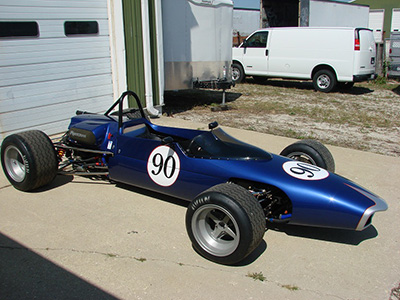
Tom Wirtz' restored Winkelmann WDB1 in 2012. Copyright Tom Wirtz 2012. Used with permission.
Mike Fazzi (Costa Mesa, CA) recalls owning a Winkelmann WDB1 in the late 1970s, having bought it less engine and gearbox. He told Palliser Registrar Locke de Bretteville that he was assured that it had been Bob Winkelmann's personal car. However, Fazzi also wrote to Don McGreevy about his car (the letter is unfortunately undated but is likely to have been in the late 1980s or early 1990s) and enclosed a picture of the car "when it was raced by Steve Rzesnowiecky". That would indicate that Fazzi had the ex-Murphy WDB1-2, not Bob Winkelmann's personal WDB1-1.
Fazzi traded this car and three others in 1998 to Tom Crowther (Novato, CA/Kentfield, CA) for a March "75B" that Crowther had built up for sale. The Winkelmann was then bought from Crowther by Tom Wirtz (Mokena, IL) in 2007, and he had restored it to race condition by 2012. He studied the WDB1 that had been for sale on race-cars.com, and noticed a number of differences, the most immediately obvious being that Wirtz' car had the perforated reinforcing panel between rollhoop and dash, and the race-cars.com car did not.
By February 2014, the WDB1 had been sold to Bob Burnside (Dexter, MI). Still owned by Burnside in September 2025.
In February 1998, race-cars.com carried an advert for a "1968 Winkelmann (Palliser) WDB-1 Formula B" located in Ohio. It was said to have had a "complete professional restoration down to the last detail". Its history was that it had been "run by Robert Winkelmann in SCCA Nationals, 3 events in 1968 and 2 in 1969", although a revision to the advert in October 1998 quoted Winkelmann directly saying he ran eight SCCA Nationals in 1968 and making no mention of the 1969 races. The car was presented in two-tone blue bodywork, and wore #88. It was sold by August 1999.
The car was acquired by Richard Hardison (Plano, TX), who entrusted Dave Handy's SascoSports (Alton, VA) with its preparation and raced it "from Texas to New York to Georgia" between 1999 and 2006. In January 2007, it was advertised again on race-cars.com still in the same two-tone bodywork and still wearing #88, but now was said to be "frame number: AM2". It was said to be the "second racecar built by Winkelmann". The claim that it was Bob Winkelmann's car had gone, replaced with a claim that it had been raced in 1969 by Rodolfo Junco. As well as the history, much of the technical detail was also different to the 1999 advert, such as the Hewland FT200 having been replaced by a Hewland Mk 5. This car had floor-mounted pedals.
It was bought from Hardison in 2008 by Francisco Mancillas (Monterrey, Mexico). He identified it as "the WDB1 that Rodolfo Junco my close friend bought new in Austin Texas". Still with Mancillas in 2025.
Palliser models
Palliser's naming convention for their range was straightforward but was sometimes misunderstood. 'W' was for Wimhurst and 'D' for Dibley, and the next letter denoted the formula. The first cars for Formula B were initially called 'WD-1', but when Wimhurst was convinced to produce a Formula Ford version, the FB car became the WDB1 and the Formula Ford the WDF1. In both cases '1' denoted the series of cars, which was an unconventional approach and would cause some confusion later. Bob Winkelmann appointed sales agents in Texas, New York, and Illinois, and the large number of WDF1 orders prompted Palliser to outsource the fabrication of frames to Arch Motors. The first Formula Ford WDF1s built on those Arch Motors frames arrived in Texas by November 1968, and by April 1969, the first of the squarer, slightly wedge-shaped 'series 2' WDB2 Formula B cars had also arrived. WDF1s were produced in large numbers in the early months of 1969, and then attention turned to a revised 'series 2' Formula Ford WDF2, inheriting the slightly wedge-shaped bodywork from the WDB2. These 'series 2' WDF2s were delivered from November 1969 to November 1970, nearly all for US customers.
Also in 1970, Palliser produced a first F3 design for the UK market. The press called this "WDF3", which misunderstood Palliser's system and would clash with the next Formula Ford model, following the WDF1 and WDF2. A more consistent name for the 'series 1' F3 car for 1970 would be the WD31. It would be followed by a 'series 2' WD32 model in 1971, but it was only when Palliser announced Damien Magee's F3 campaign in 1972 that this name was properly used. Only three F3 Pallisers were built in total.
Returning to Formula B, it would appear that the WDB2 remained Palliser's Formula B offering for the 1970 season, when four more were delivered. Then in August 1970, a revised Palliser Formula B was raced by Dibley in a UK libre race, and was then taken to be raced in the US. This appears to have been the 'series 3' WDB3, distinguished by modified front suspension, but instead of it being put into production as the 1971 FB model, it was almost immediately superseded by a new WDB4 design for Formula B and Formula Atlantic in 1971 instead. It seems likely that the WDB3 was the development car built to test Palliser's revised front suspension, incorporating upper trailing arms that mounted level with the dash. Although this arrangement could have been developed on a WDB2 frame, the change in loads may have required different bracing on the spaceframe. About this time, Palliser did introduce a different style of frame, with the X-shaped bracing of the WDB2 being superseded by V-shaped bracing. So perhaps the WDB3 was a crossbreed of 1970 frame and 1971 suspension, and was put into production with the 1971 frame as the WDB4.
Before the first WDB4 was completed, a demonstration day for Britain's new Formula Atlantic was held at Brands Hatch in December 1970, and Palliser rapidly repurposed Roger Keele's 1970 WD31 as the first Palliser Formula Atlantic demo car by fitting a Ford twin cam engine. Autosport called it a WDB3, which it definitely wasn't, as it had the standard 1970 twin-wishbone front suspension. However, Keele's car then disappeared, so it is possible it was sold off still with its Formula Atlantic engine as a WDB3.
The new frames with V-shaped bracing were also used on the Formula Super Vee WDV1, the Formula Ford WDF3, the Formula 3 WD32 that appeared in April and on both of the Palliser WDH1s built for British hillclimbs in 1971. The Arch Motors number of one of these WDH1s is a late-1970 number (AM 70/61), indicating that the first 'V' frames were delivered in late 1970. These deliveries may have been early enough for the prototype Formula Super Vee WDV1, which was raced by Harvey Staab in the US in September 1970. One of the WDV1s was displayed alongside the new WDB4 at the January 1971 Racing Car Show, showing their matching new front suspension and distinctive protruding sidepods.
Bert Ray, a freelance fabricator who had worked for Brabham, produced the fabricated front uprights for some 1971 models. He also fabricated frames for some of the Formula Atlantic WDB4s, suggesting that either the number of frames Palliser needed to satisfy orders for the WDB4 was lower than Arch Motors' minimum order, or that the extra power of the Cosworth BDA required a stronger chassis.
For 1972, a WDF4 was introduced and produced mostly in kit form to fulfil outstanding orders after Palliser ceased production.
Acknowledgements
Renny Watt (Canby, OR) and Robb Pierson (West Linn, OR) founded what was then called the Winkelmann Registry in the 1990s. Andy Antipas took over the registry from Renny Watt in February 2006 and renamed it the Palliser/Winkelmann Registry. Andy inherited all Watt and Pierson's files and used those as the basis for his pallisercars.com website launched a few months later. Locke de Bretteville then took over from Andy in 2012 and has continued the work of his predecessors. My thanks to all these gentlemen for keeping this flame alive, but particular thanks to Locke for all his help as I constructed OldRacingCars.com's pages on this marque.
If you own one of these Palliser-Winkelmanns, or have photographs that we can use, or can add to our understanding of the marque, please email Allen at allen@oldracingcars.com.
These histories were last updated on .